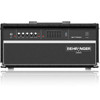Behringer ULTRABASS BVT4500H Manual - Page 6
Rear panel
 |
View all Behringer ULTRABASS BVT4500H manuals
Add to My Manuals
Save this manual to your list of manuals |
Page 6 highlights
ULTRABASS BVT4500H/BVT5500H To emphasize a tone, you can turn the relevant tone control toward 10 (maximum boost). Alternatively, you might consider lowering adjacent bands. To de-emphasize a tone, you can turn the relevant tone control toward 0 (maximum cut). ++ When you choose to cut rather than boost an audio signal, you protect audio equipment from high signal levels (clipping) and preserve valuable headroom. GRAPHIC EQ features With the TONE controls ((10) - (13)) discussed above, you emphasize and de-emphasize three fairly wide frequency bands. However, with the GRAPHIC EQ features, you can emphasize and de-emphasize 9 more narrow frequency bands. This lets you refine the sound that you created with the TONE controls. The GRAPHIC EQ features include (14)-(16): (14) EQ ON button: To turn graphic EQ and level features, push this button. (15) EQ faders: If you activated the frequency-band faders (14), you can use each one to emphasize and de-emphasize a specific frequency band. The center frequency of each frequency band is displayed directly above the relevant fader. To emphasize (boost) a frequency band, slide the relevant fader up. Alternatively, slide the faders for the surrounding frequency bands down. To de-emphasize (cut) a frequency band, slide the relevant fader down. Alternatively, slide the faders for the surrounding frequency bands up. ++ Cutting rather than boosting a frequency band protects audio equipment from high signal levels (clipping) and preserves valuable headroom. (16) LEVEL fader (BVT5500H only): To compensate possible level changes of the equalized signal, slide this control between +12 and -12. At "0" level, the BVT5500H neither boosts nor cuts the equalized signal. (17) EFFECTS MIX control (BVT5500H only): If you created an effects loop, use this control to adjust the dry-wet mix. As you turn this control toward: == 0 (zero), you hear more of the dry signal (without effects). At zero, you hear only the dry signal. == 10, you hear more of the wet signal (effects). At 10, you hear only the wet signal. For details about creating an effects loop, see 3. REAR PANEL ((29) - (30)). MASTER features (18) MASTER control: To adjust the speaker volume and the level of the PREAMP OUTPUT, turn this control toward 0 (no volume/level) or, alternatively 10 (maximum volume/level). (19) LIMITER button: The limiter reduces only the signal peaks that can overdrive the POWER AMP and distort the audio signal. The limiter prevents the BVT4500H/5500H from clipping these signal peaks. To activate or alternatively deactivate the limiter, push this button. ++ Because high signal peaks can damage loudspeakers, it is recommended to activate the limiter and not to play at full volume for a long time without ear protection. (20) LIMIT LED: When the limiter is activated, this LED is illuminated. 3. Rear panel Fig. 3.1: BVT4500H/BVT5500H rear panel This chapter describes how to use the rear panel of the BVT4500H and the BVT5500H, which includes the same features. Figure 3.1 illustrates these features. ++ To effectively use the jacks on the rear panel, you need to know about the BVT signal path. For details, refer to the secion "THE SIGNAL PATH". (21) Serial number: To register your unit, you will need this unique identifier. (22) Fuse compartment: For details about the appropriate fuse type, refer to the "SPECIFICATIONS". See also chapter 1.1.2. Replace this fuse only with the type specified for your country. (23) Power connector: To power the BVT4500H/5500H, plug the power cord in this AC connector. The power cord comes with the BVT. ++ Attention: The POWER switch does not fully disconnect the unit from the mains. Unplug the power cord completely when the unit is not used for prolonged periods of time. ++ Do not block the ventilation openings that cover the fan. PARALLEL SPEAKER OUTPUT Via the following jacks, you can simultaneously connect up to 3 speakers directly to the BVT: (25) Two ¼" TS (mono, unbalanced) jacks. (26) A single Neutrik Speakon compatible jack, for high-power loudspeakers. The pin designation of the speaker is pins 1+ and 1-. For details, refer to the chapter "AUDIO CONNECTORS". If you use a single speaker or a high-power speaker, connect this speaker to the Neutrik Speakon compatible jack. To prevent electrical shock and ensure the correct polarity, this jack locks an audio plug in place. ++ Before you connect speakers to the BVT4500H/5500H, turn it off. (24) Fan: This fan prevents the BVT4500H/5500H from overheating. 6 Rear panel















